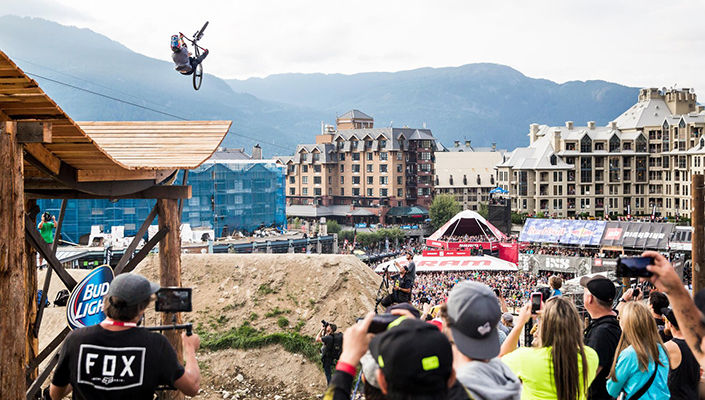
The Joyride slopestyle event at Crankworx Whistler is the premier event of the sport. Top level athletes who have battled all year to qualify for Joyride slopestyle bring their best tricks to Whistler, often learning or concocting new ones just for the event.
With riders dropping in dick-footed, doing corked-switch tricks off the whale tale, we wonder how much viewers actually understand about slopestyle and are able to follow along? It is easy to get a little lost watching events like Joyride, but don't worry, BikeRoar is here to help you make sense of it.
Let's run though what slopestyle is and the key components to a winning run.
History of Slopestyle
Slopestyle, affectionately known as 'slope,' has roots in skateboarding, the same as every action sport. Terms like switch, cab, oppo, fakie, pop, nollie, amplitude, line, and corked all come from skateboarding as early as the 1970s. BMX soon adopted some of the terms an applied them to tricks of their own. From there it's easy to see the connection between skateboarding and slopestyle MTB, but a relation to snowboarding?
RELATED: 6 Best Mountain Bike Tires for 2016
In the 90s, snowboarding exploded onto the scene with its blend of skate style and skate tricks. You can't do flip tricks on your snowboard, but essentially all the other tricks between snow and skate are the same. While skiers were busy doing twister-twister-spreads off narrow jumps in the moguls, snowboarders built downhill skateparks. Within a couple years, these gravity fed jump parks were fully adopted by mountain bikers and began to completely change the landscape and mentality of bike riding.
How Slopestyle Works
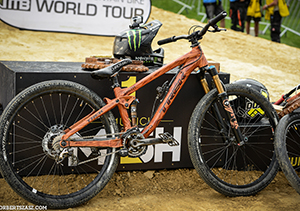
image: standmag.hu
Slopestyle bikes are usually hardtail dirtjump bikes, or low travel dual suspension bikes. Gears are usually kept to 1-3 with custom shifter mods. Riders use either mechanical or hydraulic disc brakes, and they often use a gyro cable detangler which allows them to spin the bars and bike around without the cables getting tangled. 26" tires are used exclusively, and carbon is rarely used in any components.
In slope contests, riders bike down a specially designed jump track meant to both challenge and showcase their abilities. Downhill courses combine traditional dirt jump style features as well as features borrowed from snowboard slopestyle courses. Riders compete for cash prizes and for points toward the overall Freeride Mountain Bike Association (FMB) World Tour title.
Judges watch riders closely and score them on aspects like technique (how technically clean they did all their tricks), difficulty of tricks, and amplitude of the run. Riders are usually given two runs and, depending on the particular event rules, have either their best run count or receive a combined score of the two runs.
How to Make Sense of Slopestyle Runs
This is where some of those skateboard terms come into play.
One of the biggest issues with watching slopestyle events is knowing what makes one run better than another. Tricks like backflips and tailwhips are easy to understand and usually get a big reaction from the crowd, but they score relatively low. The more advanced tricks can happen so fast and in a flurry that you may not be able to tell what the rider actually did. The most advanced riders will use subtle, but significant, differences - like spinning an opposite direction than what comes natural - in their runs to get them on top of the podium.
Standard tricks include: barspins, flips, tailwhips, 360's, x-ups, Supermans, one or no footers, and a few others, but this is good enough. Top riders will be able to combine a number of these tricks into one trick combos to score higher. For example, a top rider will do tricks like: flip-oppo-whip (back flip with a tailwhip thrown the opposite direction then natural), or a corked-7-barspin (off axis 720-degree rotation with a barspin). Get the picture? No? That's OK, let's keep elaborating.
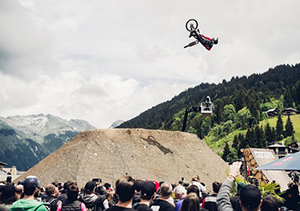
image: redbull.com
Opposite, or what is referred to as 'oppo' tricks would be like kicking a soccer ball with your wrong foot. It's tough, right? Now when you ride a bike you naturally have one foot you prefer to keep as your forward foot on your pedals and you naturally have a direction you like to spin, etc., and defying this dominant side body maneuvering scores big with the judges. Look for riders who are spinning in both directions as they will surely score higher than those who only spin in the same direction.
Corked tricks usually refer to spin or flip tricks done off-axis. A regular 720 will see the rider doing two full rotations in the same direction, a corked 720 will look like the rider combined those two rotations with a backflip. Off-axis corked tricks are harder, thus scoring better with the judges.
Riders will also often switch their feet around, placing the opposite foot forward, which allows them to spin the bars, or spin the bike in multiple directions. This is hard to see, but definitely increases the difficulty of tricks. Go out on your bike right now and try bunny hopping with your opposite foot forward on the pedals to feel what I'm talking about.
You should be getting a sense of it now, so let's review some of the most important aspects of slopestyle that are subtle to the spectator, but can make or break a winning run.
Have a look at Brandon Semenuk's 2015 Joyride run, which quickly became known as the most textbook perfect slope run ever:
Landings

image: mpora.com
Landings are incredibly important in slopestyle. If you don't land, well... you crash. Even if you don't land well, you could end up in last. Look for feet coming off the pedals, sideways landings, casing the top of the landing, and losing their grip on the handlebars. Even if a rider does incredibly hard tricks, if one foot comes off the pedals on landings, they will not score well or win.
Judges are looking for completely clean runs and the guys who win only do clean runs. Bobbling feet or hands, or not landing perfectly smooth in the right part of the landing, will cost a spot on the podium.
Switch Tricks
As previously mentioned, switch tricks are one of the main factors that separate the top 5 riders from the rest of the competition. For most spectators it can be difficult to know when a rider is performing their tricks the opposite way of what's natural, but just keep your eye on riders doing tricks both directions as they will for sure place high.
Style and Flow
Style can be a hard thing to understand or define when it comes to slopestyle riding. The easiest way to understand style it is to think about a game like hockey or soccer, where scoring a goal is like landing a trick in slopestyle. In these games you score by putting the object in the goal by almost any means necessary; no matter how ugly the play is, if it works you score a goal. In slopestyle, a rider can land a trick, but if it looks ugly, forced, or unnatural, it will not score well. So, you can land all your hardest tricks, but if you don't make them look good you can be beat by a rider whose tricks weren't as difficult, but looked a lot better.
Flow is what links the tricks together in a winning run. If a rider is landing their tricks, but they're landings are rough and they're struggling to link the jumps together, they will miss the podium. Flow is the overall continuity and style of the rider's run, so those who win slope contests make their entire run look smooth and controlled.
Take a look at last year's top 3 runs from Joyride to see what it takes to podium in slopestyle:
Now you can appreciate slopestyle even more. If you're planning to watch in-person at Crankworx, check out our Whistler insider's guide, or our how-to guide for Rotorua.
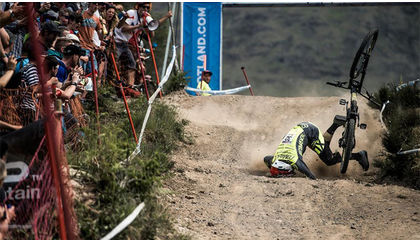
RELATED ARTICLE:
Neck Braces: Should you be wearing one?
interested in learning some new tricks? Perhaps you should be wearing a neck brace BikeRoar has you covered with a run down on neck braces and... READ MORE
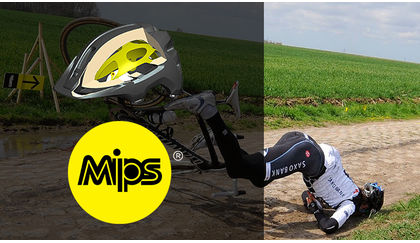
RELATED ARTICLE:
MIPS Helmets: How do they work? Should you use one?
MIPS helmets are claiming to be the next step in helmet safety and head injury prevention BikeRoar takes a look at MIPS and whether you should consider... READ MORE


